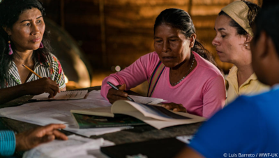The state of Indigenous Peoples’ and Local Communities’ lands and territories
A new report compiled by conservation experts and organizations, in consultation with Indigenous Peoples and their representatives, highlights the crucial role of Indigenous Peoples and local communities in protecting nature and biodiversity globally. The report shows that global biodiversity goals are unattainable without the full inclusion of Indigenous Peoples and local communities.

Photo: WWF US/Luis B
‘The State of Indigenous Peoples’ and Local Communities’ Lands and Territories’ report provides unequivocal evidence that global biodiversity goals for the Post-2020 Global Biodiversity Framework will be unattainable without full inclusion of Indigenous and local communities.
In total, 91% of IPLC lands are considered to be in good or fair ecological condition and at least 36% of the global land area covered by currently identified Key Biodiversity Areas (KBAs) lie within IPLC lands providing further evidence that IPLC custodianship is consistent with the conservation of biodiversity.
Produced collaboratively by WWF, other global conservation organizations, human rights-based NGOs, global alliances, UN entities and IPLC experts and organisations, the report offers strong and credible evidence which will inform advocacy for a truly inclusive New Deal for Nature and People and Post-2020 Global Biodiversity Framework.
Compiled with global data sets and maps and expertise from a diversity of conservation organisations, rights based organisations and peer reviewed by indigenous and local communities experts, The State of the Indigenous Peoples’ and Local Communities’ lands and territories report is the first comprehensive spatial analysis showing the extent of IPLC lands globally, their current ecological status, biodiversity and ecosystem services values, and the pressures they - and the people and communities that depend on them - continue to face.



